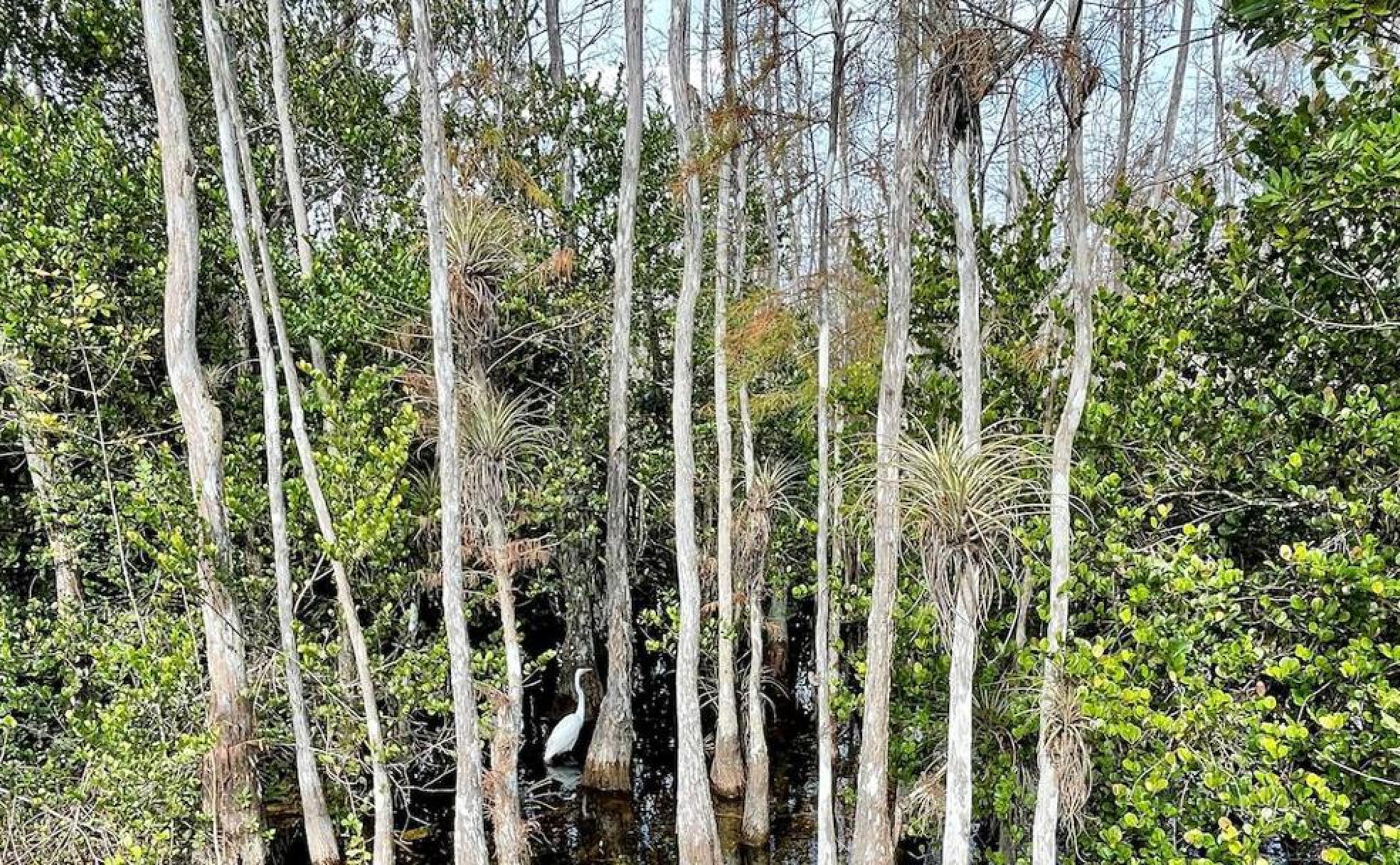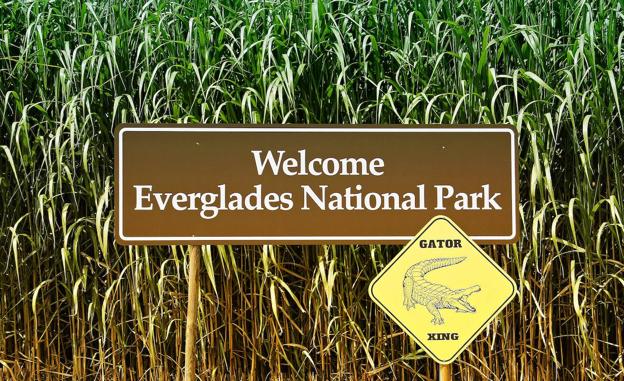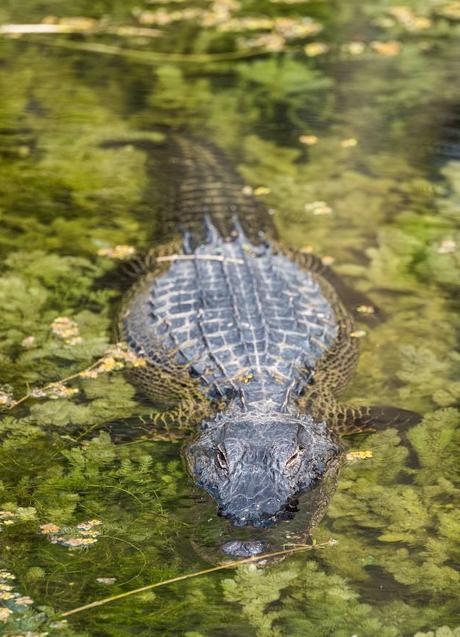

Sections
Highlight

Andrew forbes
Friday, 30 December 2022, 11:00
Floating motionless in the dappled sunlight, with the distinctive black-grey scales of its spine arching above the surface of the water, was a Florida alligator. At around two and half metres long, it made for an impressive sight.
As I moved closer to take a photo, the beast started to move. Instinctively I felt cautious and stood completely still by the water’s edge, while repeatedly reminding myself that these predatory reptiles, which have remained almost the same for the last eight million years, pose little threat to humans. Supposedly they are usually quite shy and instead take more interest in the abundant fish and birds of these vibrant wetlands – and the occasional pet dog that strays too far from its owner on a country walk.
I had left the sparkle of Miami and was heading west to Florida’s Gulf Coast. Miami is without doubt one of my favourite US cities, an invigorating gateway to a winter-sun break. The metropolis is an unofficial capital of Latin America, a lively fusion of cultures, cuisine, and creativity, where seventy per cent of residents are Hispanic, many Cuban-Americans.
After a few lively, sun-filled days, I left behind the sophistication of the city’s beach resorts, and Miami’s colourful neighbourhoods to drive across South Florida.
If you choose the multi-lane motorway, the Interstate 75, nicknamed Alligator Alley, you can speed across this lower part of the sunshine state in a few hours. Yet I had decided to make a day of it, choosing the quieter highway 41, known as the Tamiami Trail. Built in the early 20th century, this two lane road allows curious visitors to pull over, stop for photos, take detours and explore the wild immensity that is the Everglades.
This national park, the wilderness interior of South Florida, extends to some 20,000 square kilometres of swamps, wetlands, cypress forests and coastal mangroves. More than a third of the area is covered in water, and thanks to recent conservation efforts that are restoring the natural flow across the area, the Everglades are abundant with wildlife. Shoals of freshwater fish dart among delicate aquatic plants, while striking birds wade the shallows and intimidating-looking alligators lurk in silence.

In the winter, when water levels drop, it’s much easier to explore the wetlands of South Florida and catch sight of these remarkable reptiles. Many tourists taking the Tamiami Trail stop off at Shark Valley Visitor Centre, about an hour west of Miami. Here you can park up and then rent bicycles or join small tour groups to see alligators basking in the sunshine.
Yet I wanted a more tranquil experience, surrounded by the nature of this extraordinary place.
So, I exited the Highway 41 and joined the Loop Road Scenic Drive, an iconic route that runs through the remarkable scenery of the Big Cypress National Preserve, on the western edge of the Everglades. The first few kilometres of the road are tarmac, but soon enough the route narrows and becomes a dirt track, popular with hikers, cyclists and locals that like to try their luck at fishing.
Either side of the trail is dense with pine that later gives way to cypress forests that grow straight out of the shallow water. There are regular points where culverts and small bridges allow water to flow beneath the road. Here the trees are thinned out, offering amazing views deep into the cypress forests, where you’re assured to see wading birds, like brilliant white egrets, as well as herons, cormorants, and even a few silky black Anhinga, spreading out their wings in the warm sunlight.
In these dryer months, after the hurricane season, South Florida basks in Caribbean-like weather, leaving these country roads dry and easily accessible.
As its names implies, this scenic drive loops back onto the Highway 41. The Tamiami Trail is a slower way to cross the state. Admittedly you will come across roadworks, as Florida is correcting decades of damage caused to this delicate ecosystem by this old highway that ‘cut’ the Everglades in half.
Now portions of the 41 are being raised up, creating bridges and overpasses that allow the life-giving water to flow more freely once again across the entirety of the Everglades and the neighbouring national preserves.
The charm of this less popular route is that you feel much more connected with the landscape, which remains largely undeveloped. As you leave Miami and enter the Everglades, you’ll pass tourist stops offering Air Boat rides over the swamps to mangrove islands. Then after a few more kilometres, the wetlands change to spruce, pine, and cypress forests. Road signs warn of the occasional crossing area for the rare Florida Black Panther. You’ll notice that your mobile phone signal slowly deteriorates to nothing – you have entered the swampy wilderness of South Florida.

Before reaching the Gulf Coast, there’s another detour I recommend, just off the 41, called the Big Cypress Bend Boardwalk. This elevated timber path meanders for a couple of kilometres through dense vegetation, offering a self-guided tour, with the help of information boards. It’s an accessible and safe way to get amongst the flora and fauna of the wetlands.
One passes ancient trees almost strangled by thick, twisted vines, architectural royal palms that tower to more than 15 metres, and delicate cypress trees, with branches covered in Spanish moss, and silvery grey air plants. The occasional pop of winter colour comes from bromeliads and, later in spring, abundant orchids. Florida is among the fastest growing states in the US, yet here the booming cities and wealthy coastal resorts feel a world away.
However, after rejoining the highway, soon enough after less than an hour or so on the road, the Everglades soundtrack of egret squawks and squeals and the croaks of frogs was replaced with the sounds of traffic and modern civilisation.
Driving through the chic coastal city of Naples offers a glimpse of the luxury lifestyle on the shores of Florida’s Gulf Coast, with kilometre after kilometre of upscale, gated communities where once wild landscapes have been dredged and transformed into manicured havens for privileged retirees.
As the day drew to an end, and the intense colours of a gulf sunset ignited the sky, I arrived in a coastal community west of Fort Myers, overlooking Sanibel and on towards Captiva island.
Winter, from December to March, is the best time to visit this cluster of glorious barrier islands on the Gulf of Mexico, where dense, verdant mangroves surround tidal lagoons and border white sandy beaches.
I was last here almost twenty years ago, yet Sanibel island has retained its old Florida charm.
Pastel, ‘candy-coloured’ houses are set among coconut palms and no building towers above the trees. Sanibel is ideally orientated to catch shells, brought up by the gulf currents. So be prepared to get the Sanibel Stoop, as you bend to look down for fighting conch, lighting whelks and shiny olive shells on the shore.
It’s legal to go shelling at places like Bowman’s beach, so long as you only take empty shells. Chatting to locals, I was recommended to get there early and walk the beaches as the tide rolls back in the morning, revealing the natural treasures of the gulf.
Sanibel and neighbouring Captiva are easily reached by road from Fort Myers.
From these islands one can board the boat services and private water taxis to the more isolated islands of southwest Florida. So, one can have lunch at Cabbage Key Inn or live the high life for a day on the exclusive island of Gasparilla, home to the posh Gasparilla Inn and Club, and the postcard perfect 19th century Port Boca Grande Lighthouse.
From the cosmopolitan gateway of Miami, a day tailing alligators in the Everglades, to the sub-tropical warmth and white sand beaches of a hundred Gulf Coast islands, this is an unforgettable itinerary for a winter sun holiday.
Noticia Patrocinada
Publicidad
Paco Griñán | Málaga
Encarni Hinojosa | Málaga
Cristina Cándido y Álex Sánchez
Esta funcionalidad es exclusiva para registrados.
Reporta un error en esta noticia

Debido a un error no hemos podido dar de alta tu suscripción.
Por favor, ponte en contacto con Atención al Cliente.

¡Bienvenido a SURINENGLISH!

Tu suscripción con Google se ha realizado correctamente, pero ya tenías otra suscripción activa en SURINENGLISH.
Déjanos tus datos y nos pondremos en contacto contigo para analizar tu caso

¡Tu suscripción con Google se ha realizado correctamente!
La compra se ha asociado al siguiente email
Comentar es una ventaja exclusiva para registrados
¿Ya eres registrado?
Inicia sesiónNecesitas ser suscriptor para poder votar.